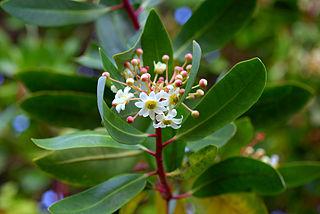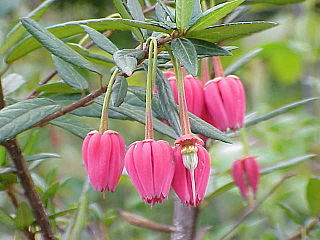
The Annonaceae are a family of flowering plants consisting of trees, shrubs, or rarely lianas commonly known as the custard apple family or soursop family. With 108 accepted genera and about 2400 known species, it is the largest family in the Magnoliales. Several genera produce edible fruit, most notably Annona, Anonidium, Asimina, Rollinia, and Uvaria. Its type genus is Annona. The family is concentrated in the tropics, with few species found in temperate regions. About 900 species are Neotropical, 450 are Afrotropical, and the remaining are Indomalayan.

Winteraceae is a primitive family of tropical trees and shrubs including 93 species in five genera. It is of particular interest because it is such a primitive angiosperm family, distantly related to Magnoliaceae, though it has a much more southern distribution. Plants in this family grow mostly in the southern hemisphere, and have been found in tropical to temperate climate regions of Malesia, Oceania, eastern Australia, New Zealand, Madagascar and the Neotropics, with most of the genera concentrated in Australasia and Malesia. The five genera, Takhtajania, Tasmannia, Drimys, Pseudowintera, and Zygogynum s.l. all have distinct geographic extant populations. Takhtajania includes a single species, T. perrieri, endemic only to Madagascar, Tasmannia has the largest distribution of genera in Winteraceae with species across the Philippines, Borneo, New Guinea, Eastern Australia, and Tasmannia, Drimys is found in the Neotropical realm, from southern Mexico to the subarctic forests of southern South America, Pseudowintera is found only in New Zealand, and Zygogynum has species in New Guinea and New Caledonia.

The Canellaceae are a family of flowering plants in the order Canellales. The order includes only one other family, the Winteraceae. Canellaceae is native to the Afrotropical and Neotropical realms. They are small to medium trees, rarely shrubs, evergreen and aromatic. The flowers and fruit are often red.

Joseph Marie Henry Alfred Perrier de la Bâthie was a French botanist who specialized in the plants of Madagascar.

Elaeocarpaceae is a family of flowering plants. The family contains approximately 615 species of trees and shrubs in 12 genera. The largest genera are Elaeocarpus, with about 350 species, and Sloanea, with about 120.

The Myristicaceae are a family of flowering plants native to Africa, Asia, Pacific islands, and the Americas and has been recognized by most taxonomists. It is sometimes called the "nutmeg family", after its most famous member, Myristica fragrans, the source of the spices nutmeg and mace. The best known genera are Myristica in Asia and Virola in the Neotropics.

Siparunaceae is a family of flowering plants in the magnoliid order Laurales. It consists of two genera of woody plants, with essential oils: Glossocalyx in West Africa and Siparuna in the neotropics. Glossocalyx is monospecific and Siparuna has about 74 known species.
René Paul Raymond Capuron was a French botanist. Capuron was responsible for an extensive amount of work on the tree flora of Madagascar. Several tree taxa with the specific epithet of capuronii honor his name, examples being Podocarpus capuronii and Schizolaena capuronii.

Chuniophoenix is a genus of palm tree named after Chun Woon-Young, then director of the Botanical Institute, Sun Yat Sen University, Guangzhou. It contains three known species, native to southern China and Vietnam. Chuniophoenix is a member of tribe Chuniophoeniceae, a small group of palms that exhibit great morphological diversity and interesting biogeography. The tribe includes four genera: Chuniophoenix with 3 species in China and Vietnam, Kerriodoxa (monotypic) in Peninsular Malaysia and Thailand, Nannorrhops (monotypic) from Arabia to Afghanistan, and Tahina (monotypic) in Madagascar.
Eucarpha is a genus of flowering plant of the family Proteaceae, endemic to New Caledonia. Two species are recognised. Up to 1975, these were classified within the genus Knightia until Lawrence Johnson and Barbara G. Briggs recognised their distinctness, particularly their prominent bracts, in their 1975 monograph "On the Proteaceae: the evolution and classification of a southern family". Nomenclatural combinations for these two species in the genus Eucarpha were published in 2022.
Perrierosedum is a genus of succulent plants of the family Crassulaceae that is endemic to Madagascar and contains only the single species Perrierosedum madagascariense.

Lopezia is a genus of plants of the family Onagraceae, largely restricted to Mexico and Central America.
Perrierodendron is a genus of trees and shrubs in the family Sarcolaenaceae. They are endemic to Madagascar.
Mauloutchia is a genus of trees endemic to the lowland eastern and northern rain forests of Madagascar. They can be distinguished by their non-monocyclic androecium with anthers basifixed and borne on short filaments.

The Malmeoideae are a subfamily of trees and other plants of the family Annonaceae.
Gonzalezia is a genus of flowering plants belonging to the family Asteraceae.
Jumelleanthus is a monotypic genus of flowering plants belonging to the family Malvaceae. It only contains one species, Jumelleanthus perrieriHochr.
Kuhlmanniodendron is a genus of flowering plants belonging to the family Achariaceae.

Sidneya is a genus of flowering plants belonging to the family Asteraceae.
Heiseria is a genus of flowering plants belonging to the family Asteraceae.










